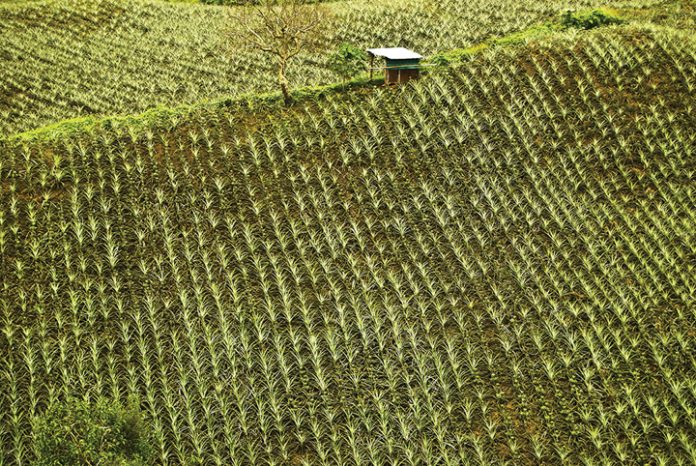Jasper Emmanuel Y. Arcalas & Catherine Marie N. Pillas (BusinessMirror)

REGULATORS appear to be using their coconuts in grappling with the “Made in the Philippines” tag on exports.
At least for those in the Department of Agriculture (DA) and the Department of Trade and Industry (DTI), they see the potentials of products from local fiber and the lowly coconut bearing the “Proudly Philippine-made” tag.
For one, the DA is keen on capitalizing on the market opportunities for pineapple leaf fiber, which is currently used as an alternative to manufacture leather-based products. This is aside from also stepping up the local abaca production.
The Department of Trade and Industry’s Export Marketing Bureau (EMB), tasked to push, promote and develop the country’s local exports globally, notes that the Philippines is actually a “champion” in both coconut production and exporting.
EMB Director Senen M. Perlada said the Philippines, with 68 coconut-producing provinces, is only second to Indonesia in global production of coconuts, and the No. 1 exporter of coconut oil.
Top honchos
IN December last year, Agriculture Secretary Emmanuel F. Piñol met with the top honchos of Nonwoven Fabrics Philippines Inc. (NFPI) and Ananas Anam Ltd. (AAL). The former manufactures Piñatex substrate, while AAL converts Piñatex substrate into leather alternative material.
Both NFPI and AAL expressed interest in hiking their local procurement of pineapple leaves from the country’s local producers.
The UK-based company AAL founder Carmen Hijosa, who is a scientist by profession, developed a technology which processes pineapple leaves into leather used by shoemakers, furniture designers and car manufacturers. Hijosa called this “Piñatex”. It was first presented at the Doctor of Philosophy graduate exhibition at the Royal College of Art, London.
On March 7 at simple rites in Malacañang, the Philippine Fiber Industry Development Authority (PhilFida) turned over some P8.5-million worth of processing and postharvest facilities to five farmers’ cooperatives for the commercial production of pineapple fibers.
During the turnover ceremony, Piñol admitted that despite the huge demand and recognition from other countries for pineapple leaf fiber, the commercialization of pineapple fiber by-products in the country has not been maximized.
Piñol added that pineapple leaves and pulp are usually left to rot in the field before huge tractors are fielded to prepare the area again for the next planting season, instead of being processed for fiber.
“With this development, hundreds of tons of pineapple leaves, which were left in the field to rot in the past, can now be the source of income for poor farmers to be able to send their children to school,” Piñol said.
Volume requirement
THE PhilFida also identified the five cooperatives that will supply pineapple fibers to the NFPI.
To meet the volume requirement for the initial demand of 50 tons of pineapple fibers in 2017, the PhilFida is providing various agricultural machineries to several beneficiary groups, which include the Adventurers Multipurpose Cooperative in Polomolok and the T’boli Farm Growers Multipurpose Cooperative in T’boli in South Cotabato. Other beneficiaries are the Shalom Fiber Growers Association in Manolo Fortich in Bukidnon, the Maduvika Farmers Cooperative in Santa Ana, Cagayan, and the Labo Progressive Multipurpose Cooperative in Camarines Norte.
After meeting with AAL in December, Piñol said Dole Philippines Inc. has thrown its support behind the DA’s pineapple-based leather-production project for the poor.
The agriculture chief said Dole Philippines will ink a memorandum of agreement with the DA to formalize the multinational firm’s support for the livelihood project.
Top officials of Dole Philippines have pledged to donate to poor families pineapple leaves from their 18,000-hectare plantations all over Mindanao, Piñol posted on his Facebook account. He added that in a meeting with officials of Dole Philippines led by Carlos H. Mandujano, senior vice president for worldwide agriculture and research, “I asked them to allow poor families to gather pineapple leaves after the fruits are harvested.”
Potential deal
PIÑOL said the DA is keen on signing the MOA with Dole Philippines to formalize the multinational firm’s support for the production of pineapple fiber.
Under the MOA, Dole Philippines will provide pineapple leaves to poor families living near the plantations, while the DA will provide technical support and decorticating machines, including dryers, according to Piñol.
“With over 18,000 hectares of pineapple plantations, Dole Philippines’s support to the Piñatex natural leather production could lift thousands of farmers from poverty,” he said.
“Hopefully, I will be able to convince the other companies involved in pineapple production, such as Sumifru and Del Monte, to follow the example of Dole Philippines,” the DA chief added.
According to the DA, the Philippines is the top exporter of juice concentrates and pineapple juice.
Most of the pineapple products shipped abroad come from Mindanao. Pineapple is processed into puree, dried, juice concentrates, canned products and fruit cocktail in syrup that are intended for export.
The Philippines is second to Thailand in terms of processing. The DA said 85 percent of processing belongs to companies like Del Monte and Dole.
There are 28 processing plants in the Philippines.
The DA said native Philippine red or Spanish red, when processed, is an excellent source of piña fiber.
Ultimate fruit
COCONUT products, specifically coconut oil, remain to be a critical export commodity of the Philippines, but their potential is being dampened by a common problem in local, agro-based products: low productivity of the nut.
In particular, the shifting trend toward organic products and the subsequent skyrocketing demand of virgin coconut oil (VCO) from Western markets have been a boon for the Philippines.
The US imported $109 million worth of virgin coconut oil in 2012-2013 according to EMB data. Japan has since overtaken the US as the top market for VCO.
California-based organic firm Nutiva, which sources from the Philippines, sells a 54-fluid-ounce of virgin coconut oil at $41.
But the outlook hasn’t been rosy for coconut oil in the past two years: a spate of natural disasters has kept coconut production volumes low.
“The difficulty we’ve had in recent years is that shipments have declined mainly because of production. We’ve been hit by Haiyan [Supertyphoon Yolanda] and El Niño; all these natural disasters have affected us, especially in coconut-producing regions,” Perlada said in a recent interview.
Low productivity
ACCORDING to data from the Philippine Statistics Authority and gathered by the EMB, value of coconut oil shipments from the Philippines reached a high of P279 million in the 2012-to-2013 period, but has declined to the $100-million levels in the subsequent years.
The production volume of coconuts followed a similar decline in the past two to three years.
The low productivity in agriculture sector is no new phenomenon: the coconut sector, like the broader sector, suffers from under-investment.
Low production levels of coconuts means that the country’s diversifying portfolio of coconut products—crude oil, hydrogenated coconut oil, coconut meat, coconut water, processed food—has to compete for the same raw material.
“We could not take full advantage of being able to supply what the market needs for coconut products. We have limited material and that material has alternative uses. What if there was demand for all products—both the commodities and the nontraditional, high-value products? We have to prioritize. If we had an abundant supply, we wouldn’t have those problems,” the government official said.
Other hurdles
ACCORDING to Ma. Melvin Joves, product officer at the DTI-EMB for the Coconut, Food and Agri-Marine division, there are other hurdles in growing the coconut exports sector.
“There’s underinvestment, of course, and replanting is a problem,” Joves said. “A lot of our trees are already so old. Investment is really lagging.”
“Those are some of the issues in the industry: one is the number of trees, and two, the productivity per tree,” Perlada added.
The untapped opportunity in the sector, in terms of employment, is also surprisingly significant. Perlada pointed out that every P1-million increase in the value of shipments of coconut oil has a potential to create 30 jobs (compared to mangoes whose employment multiplier is 1.017).
Even with this existing problem, the DTI sees at least a positive production level this year, or some 6 to 7 percent growth.
The year will be the first positive production year since 2015, as the country recovers from the destruction of Haiyan.
The government and the coconut industry have set a coconut production volume growth of 20 percent annually from 2010’s baseline of 15 billion nuts, up to 2025 in its coconut industry road map.
While this annual 20-percent target has not been met, the production volume has been revised downward to a more conservative 10 percent.
